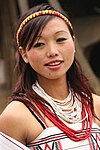Sangtam Naga
[2] Like many other ethnic groups in Northeast India, they practice jhum, or shifting cultivation.Unlike other Naga ethnic groups in Nagaland, many of the Sangtam have retained their traditional beliefs in spite of embracing Christianity at the same time.Sangtams celebrate twelve different festivals, in particular Mungmung, all of which are affiliated with their traditional culture and religion.Towards the south-eastern part of Nagaland, they inhabit the Kiphire District.The northern part of Sangtam includes the Longkhim-Chare sub-division of Tuensang District.
Naga woman
Sangtam languageNaga peopleethnic groupKiphire DistrictNortheast IndianNagalandshifting cultivationMungmungTuensang DistrictMüriseChümoukedima DistrictDimapur DistrictChakhesang NagaAngamiChakhesangChotheKharamKhiamniunganKonyakLainongLamkangLiangmaiMakuryMaringMonsangPochuryPoumaiRengmaRongmeiTangkhulTangsaThangalTikhirWanchoYimkhiungHill tribes of Northeast IndiaMizoramChakmaDimasa (Kachari)HajongKhasi and JaintiaSynteng or PnarLyngngamKuki TribesMan (Tai speaking)Mizo (Lushai) tribesMikir (Karbi)Naga tribesPawi (Lai)Synteng (Pnar)YimkhiungNagaBodo-KachariMeghalayaKhasi Synteng or PnarLakher (Mara)Arunachal PradeshAbor (Galo)Aka (Hruso)ApataniDafla (Nyishi)GalongKhowa (Bugun)MishmiMiju MishmiChugpaLishipaSherdukpenSingpho (Jingpo)Tai peoplesKhamptiKhamyangKhambaMinyongMishing (Miri)PuroikZekhringManipurGangteKoirao (Thangal)KoirengSuhte (Paite)ThadouVaipheiTripuraBhutiaJamatiaKhasiaLepchaLushai (Mizo)Munda, KaurNoatiaSantalTripuriSikkimSherpaTibetanHrangkhwal, RangkholKhelmaSairhem TangsaList of Scheduled Tribes in India